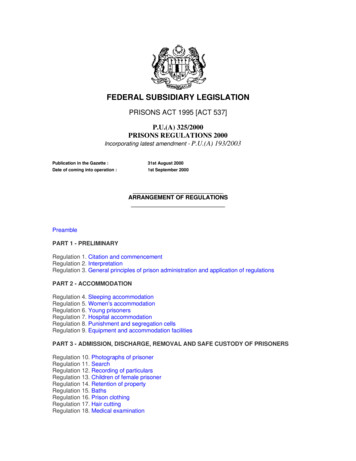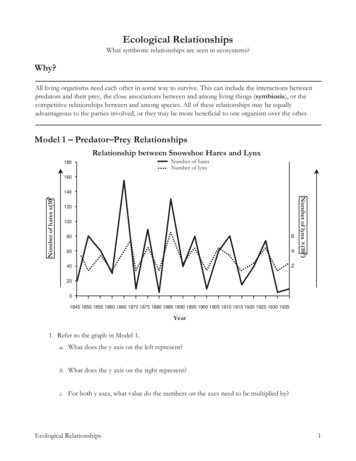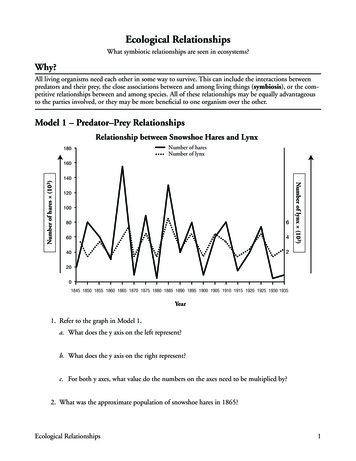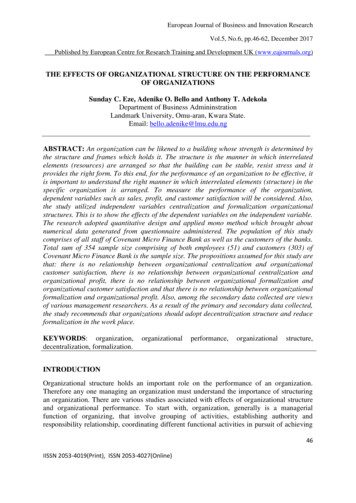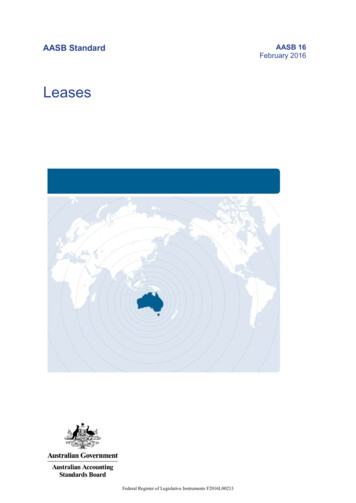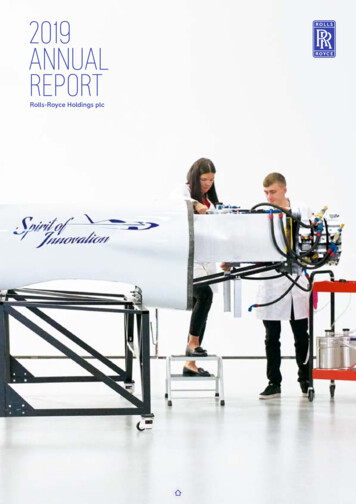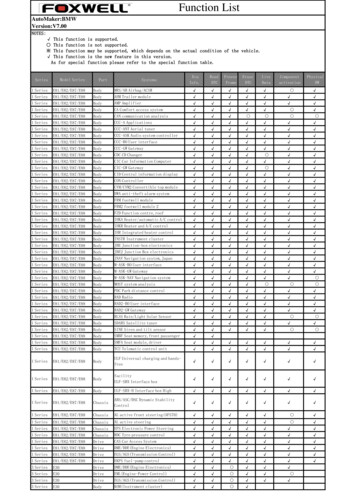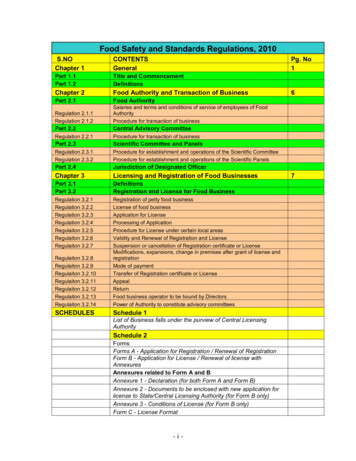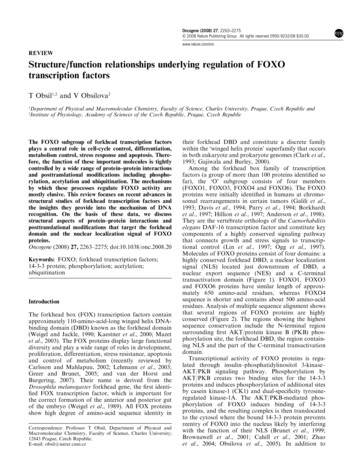
Transcription
Oncogene (2008) 27, 2263–2275& 2008 Nature Publishing Group All rights reserved 0950-9232/08 30.00www.nature.com/oncREVIEWStructure/function relationships underlying regulation of FOXOtranscription factorsT Obsil1,2 and V Obsilova21Department of Physical and Macromolecular Chemistry, Faculty of Science, Charles University, Prague, Czech Republic andInstitute of Physiology, Academy of Sciences of the Czech Republic, Prague, Czech Republic2The FOXO subgroup of forkhead transcription factorsplays a central role in cell-cycle control, differentiation,metabolism control, stress response and apoptosis. Therefore, the function of these important molecules is tightlycontrolled by a wide range of protein–protein interactionsand posttranslational modifications including phosphorylation, acetylation and ubiquitination. The mechanismsby which these processes regulate FOXO activity aremostly elusive. This review focuses on recent advances instructural studies of forkhead transcription factors andthe insights they provide into the mechanism of DNArecognition. On the basis of these data, we discussstructural aspects of protein–protein interactions andposttranslational modifications that target the forkheaddomain and the nuclear localization signal of FOXOproteins.Oncogene (2008) 27, 2263–2275; doi:10.1038/onc.2008.20Keywords: FOXO; forkhead transcription factors;14-3-3 protein; phosphorylation; acetylation;ubiquitinationIntroductionThe forkhead box (FOX) transcription factors containapproximately 110-amino-acid-long winged helix DNAbinding domain (DBD) known as the forkhead domain(Weigel and Jackle, 1990; Kaestner et al., 2000; Mazetet al., 2003). The FOX proteins display large functionaldiversity and play a wide range of roles in development,proliferation, differentiation, stress resistance, apoptosisand control of metabolism (recently reviewed byCarlsson and Mahlapuu, 2002; Lehmann et al., 2003;Greer and Brunet, 2005; and van der Horst andBurgering, 2007). Their name is derived from theDrosophila melanogaster forkhead gene, the first identified FOX transcription factor, which is important forthe correct formation of the anterior and posterior gutof the embryo (Weigel et al., 1989). All FOX proteinsshow high degree of amino-acid sequence identity inCorrespondence: Professor T Obsil, Department of Physical andMacromolecular Chemistry, Faculty of Science, Charles University;12843 Prague, Czech Republic.E-mail: obsil@natur.cuni.cztheir forkhead DBD and constitute a discrete familywithin the ‘winged helix protein’ superfamily that occursin both eukaryote and prokaryote genomes (Clark et al.,1993; Gajiwala and Burley, 2000).Among the forkhead box family of transcriptionfactors (a group of more than 100 proteins identified sofar), the ‘O’ subgroup consists of four members(FOXO1, FOXO3, FOXO4 and FOXO6). The FOXOproteins were initially identified in humans at chromosomal rearrangements in certain tumors (Galili et al.,1993; Davis et al., 1994; Parry et al., 1994; Borkhardtet al., 1997; Hillion et al., 1997; Anderson et al., 1998).They are the vertebrate orthologs of the Caenorhabditiselegans DAF-16 transcription factor and constitute keycomponents of a highly conserved signaling pathwaythat connects growth and stress signals to transcriptional control (Lin et al., 1997; Ogg et al., 1997).Molecules of FOXO proteins consist of four domains: ahighly conserved forkhead DBD, a nuclear localizationsignal (NLS) located just downstream of DBD, anuclear export sequence (NES) and a C-terminaltransactivation domain (Figure 1). FOXO1, FOXO3and FOXO6 proteins have similar length of approximately 650 amino-acid residues, whereas FOXO4sequence is shorter and contains about 500 amino-acidresidues. Analysis of multiple sequence alignment showsthat several regions of FOXO proteins are highlyconserved (Figure 2). The regions showing the highestsequence conservation include the N-terminal regionsurrounding first AKT/protein kinase B (PKB) phosphorylation site, the forkhead DBD, the region containing NLS and the part of the C-terminal transactivationdomain.Transcriptional activity of FOXO proteins is regulated through insulin–phosphatidylinositol 3-kinase–AKT/PKB signaling pathway. Phosphorylation byAKT/PKB creates two binding sites for the 14-3-3proteins and induces phosphorylation of additional sitesby casein kinase-1 (CK1) and dual-specificity tyrosineregulated kinase-1A. The AKT/PKB-mediated phosphorylation of FOXO induces binding of 14-3-3proteins, and the resulting complex is then translocatedto the cytosol where the bound 14-3-3 protein preventsreentry of FOXO into the nucleus likely by interferingwith the function of their NLS (Brunet et al., 1999;Brownawell et al., 2001; Cahill et al., 2001; Zhaoet al., 2004; Obsilova et al., 2005). In addition to
Structure/function relationships in FOXO proteinsT Obsil and V Obsilova2264Figure 1 Schematic representation of primary structure of FOXO proteins. All FOXO proteins have the same domain organizationand contain forkhead DNA-binding domain (DBD), nuclear localization signal (NLS), nuclear export sequence (NES) andtransactivation domain (TA). Only the AKT/protein kinase B (PKB) phosphorylation sites are shown.Figure 2 Sequence alignment and posttranslational modifications of FOXO subgroup members. Residues that are conserved at leastin three sequences are shaded in gray. Residue color coding: brown, AKT/protein kinase B (PKB)/serum- and glucocorticoid-induciblekinase (SGK) phosphorylation sites; red, non-AKT/PKB phosphorylation sites; and green, acetylation sites. Symbol ( ) denotesmonoubiquitination sites. Regions of nuclear localization signal (NLS) and nuclear export sequence (NES) motifs are labeled by yellowboxes. Question marks indicate unknown acetylating enzymes. Symbol (#) denotes oxidative stress-induced phosphorylation events(Brunet et al., 2004). Symbol (*) denotes sites phosphorylated by mitogen-activated kinases ERK and p38 (Asada et al., 2007). CBP,cyclic-AMP responsive element binding (CREB)-binding protein; cGK1, cyclic GMP-dependent kinase-1; DIRK1, dual-specificitytyrosine-regulated kinase-1A; JNK, c-JUN N-terminal kinase.AKT/PKB-mediated phosphorylation, the function ofFOXO proteins is also controlled by other types ofposttranslational modifications including non-AKT/PKB-mediated phosphorylation, acetylation and ubiquitination. Sites of these posttranslational modifications are often located within the conserved regions ofOncogeneFOXO molecule (Figure 2). The precise mechanisms bywhich posttranslational modifications regulate FOXOfunctions are mostly elusive, but in many cases theyseem to affect DNA-binding potential of FOXOproteins, function of their NLS and NES, or interactions of FOXO with other proteins.
Structure/function relationships in FOXO proteinsT Obsil and V Obsilova2265This review focuses on recent advances in structuralstudies of forkhead transcription factors and the insightsthey provide into the mechanism of DNA recognition.On the basis of these data, we discuss structural aspectsof protein–protein interactions and posttranslationalmodifications that target the forkhead domain and theNLS of FOXO proteins.Structure of forkhead DNA-binding domainStructural studies of forkhead proteins began with thesolution of co-crystal structure of the DBD of a FoxA3(HNF-3g) DNA complex (Clark et al., 1993). FoxA3 isa liver-specific transcription factor that plays importantroles in cell differentiation and tissue-specific geneexpression (Lai et al., 1993). Its structure showed thatthe forkhead/winged helix motif is a compact structurecontaining about 110 amino-acid residues that foldinto three a-helices (H1, H2 and H3), three b-strands(S1, S2 and S3) and two wing-like loops (W1 and W2)(Figure 3). Topologically, the arrangement of thedomain is H1 S1 H2 H3 S2 W1 S3 W2. Thestrand S1, inserted between helices H1 and H2, interactswith strands S2 and S3 to form a three-stranded,twisted, antiparallel b-sheet. While the N-terminal partof the domain is formed by a cluster of three a-helices,the C-terminal half consists of b-strands S2 and S3 andtwo large loops (wings W1 and W2) that protrude fromb-sheet.More recently, several three-dimensional structures offorkhead domains have been determined using X-raycrystallography or nuclear magnetic resonance spectroscopy. These new data revealed that among variousforkhead domains, there are small variations in thesecondary structure content and topological arrangement (Figure 4). Forkhead domains of FOXO4 (humanAFX) (Weigelt et al., 2001), FoxD3 (Genesis) (Marsdenet al., 1998), FOXC2 (FREAC-11) (van Dongen et al.,2000) and FoxQ1 (HFH-1) (Sheng et al., 2002) containan additional short 310-type helix located betweena-helices H2 and H3. Structures of DNA complexes ofFoxD3 DBD (Genesis) (Jin and Liao, 1999), FOXK1aDBD (ILF-1) (Tsai et al., 2006), FOXP2 DBD (Stroudet al., 2006) and an apo-form of FOXK1a DBD (ILF-1)(Liu et al., 2002) show that these forkhead domainscontain an additional helix located at the C terminusdownstream of b-strand S3. It seems that in the case ofFoxD3, the formation of this C-terminal helix is inducedby the binding to the target DNA (Marsden et al., 1998;Jin and Liao, 1999). On the other hand, the C terminusof FOXK1a DBD has helical fold both in the absenceand presence of DNA, suggesting that the C-terminalhelix can be a native part of the forkhead motif (Liuet al., 2002; Tsai et al., 2006).Mechanism of DNA recognition by FOX proteinsForkhead proteins share similar binding specificity tothe core sequence 50 -(A/C)AA(C/T)A-30 (Overdier et al.,1994; Kaufmann et al., 1995; Weigelt et al., 2001).However, different classes of forkhead proteins recognize diverse DNA sequences adjacent to the coresequence through still not fully understood mechanism.To date, six structures of forkhead domains bound toDNA have been solved: FoxA3 DNA (Clark et al.,1993), FoxD3 DNA (Jin and Liao, 1999), FOXP2 DNA (Stroud et al., 2006), NFAT FOXP2 DNA (Wuet al., 2006), FOXK1a DNA (Tsai et al., 2006) andFOXO3a DNA (Tsai et al., 2007). Structure ofFoxA3 DNA complex provided first details aboutinteractions between forkhead DBD and the coresequence, showing that the helix H3 represents the mainDNA recognition site (Clark et al., 1993). The forkheaddomain of FoxA3 binds to the DNA duplex as amonomer with the helix H3 docked into the majorgroove roughly perpendicular to the DNA axis providing extensive interactions with the core sequence.Residues that are involved in these interactions(Asn165 and His169) are highly conserved among allforkhead proteins (Figure 3c). Contacts between forkhead domain and DNA involve direct hydrogen bondsbetween side chains and bases, water-mediated sidechain base interactions and van der Waals contactswith both the bases and the backbone of DNA (Figures5a and 6a). Other regions of FoxA3 DBD that makeimportant interactions with DNA, in addition torecognition helix H3, are both wings W1 and W2flanking the helix H3. Mainly the wing W2 was shown tobe an important part of DNA-binding interface. Thisloop, emerging from the C terminus of b-strand S3,makes both specific and unspecific contacts with themajor and minor grooves of the DNA. The binding ofFoxA3 DBD also induces a bend of 131 in the DNAduplex narrowing the major groove in which the helixH3 is located (Clark et al., 1993).Transcription factor FoxD3 is a transcriptionalrepressor, whose expression is restricted to embryonicstem cells and certain tumor cell lines (Sutton et al.,1996). Solution nuclear magnetic resonance structure ofits DNA complex demonstrated that FoxD3 uses similarmechanism of DNA recognition employing the sameresidues from helix H3 and wing W2 (Jin and Liao,1999). However, the question is how to explain thatFoxA3 and FoxD3 recognize significantly differentDNA sequences while possessing almost identicalrecognition helix H3? It has been suggested that thesedifferences arise from less conserved regions outside ofthe main DNA-binding interface. Pierrou et al. (1994)showed that amino-acid residues around the N-terminalborder of helix H3 and in the wing W2 determine, atleast in part, the DNA-binding specificity. In addition,studies on chimeras of HFH proteins have shown thatresidues from the loop between helices H2 and H3modulate binding specificity probably through therepositioning of the recognition helix H3 (Overdieret al., 1994). The loop-linking helices H2 and H3 and thewing W2 can adopt different conformations in differentforkhead domains. For example, these two regionsadopt a helical structure in the FoxD3 DNA complex,but a coiled structure in the FoxA3 DNA complex(Clark et al., 1993; Jin and Liao, 1999). The role ofOncogene
Structure/function relationships in FOXO proteinsT Obsil and V Obsilova2266Figure 3 Three-dimensional structure of the forkhead domain. (a) Ribbon representation of the solution structure of FOXO4forkhead domain sequence Ser92-Gly181 (Weigelt et al., 2001). (b) Topology of the forkhead domain. Helices H4 and H5 are presentonly in certain forkhead domains. (c) Sequence alignment of FOXO forkhead domains and forkhead domains from availablestructures of FOX DNA complexes. Secondary structure elements are indicated at the top. Residue color coding: blue, residuesinvolved in protein–DNA contacts (Clark et al., 1993; Jin and Liao, 1999; Stroud et al., 2006; Tsai et al., 2006, 2007); gray, residues ofFOXO4 that were predicted to be involved in DNA binding based on homology modeling (Boura et al., 2007); brown, AKT/proteinkinase B (PKB)/serum- and glucocorticoid-inducible kinase (SGK) phosphorylation sites; red, non-AKT/PKB phosphorylation sites;and green, acetylation sites. Symbol (*) means that the residues in that column are identical in all sequences in the alignment. Symbol(:) means that conserved substitutions have been observed. Symbol (.) means that semiconserved substitutions are observed.highly flexible wings W1 and W2 in the specificity andtightness of DNA binding was further investigated byShiyanova and Liao (1999), who showed that substitutions of non-DNA contact residues in wing sequencescan dramatically change the dissociation rate ofFoxD3 DNA complex. Comparison and analysis ofthe FOXC2 and FoxD3 structures also suggested thatthe positions of wings W1 and W2, which are stronglycoupled to the position of the b-sheet, are correlated tothe position of the DNA-recognition helix H3 (vanDongen et al., 2000).Recently, four new crystal structures of forkhead DBDbound to the target DNA have been solved: FOXP2 DNA (Stroud et al., 2006), NFAT FOXP2 DNA(Wu et al., 2006), FOXK1a DNA (Tsai et al., 2006)and FOXO3a DNA (Tsai et al., 2007). Although theoverall recognition of core sequence by helix H3 is inOncogeneall four cases similar to that seen in FoxA3 DNAstructure, the recognition patterns are different (Figures5 and 6). In FOXK1a DNA complex, residues from therecognition helix H3 interact with eight bases of theDNA duplex through direct hydrogen bonds, watermediated interactions and van der Waals contacts(Figures 5b and 6b). In addition to the contacts withthe major groove, both the wing W1 and the C-terminalsegment of FOXK1a interact with the minor groove ofDNA and appear to be important for DNA recognition.The wing W1 recognizes the TA sequence 1 bp downstream from the 50 -TAAACA-30 core sequence andmakes several other contacts with phosphate groups.Cluster of basic residues following helix H4 in theC terminus of FOXK1a DBD interacts with nucleotidesupstream from the core sequence through hydrogenbonds and bridging water molecules. In the periphery of
Structure/function relationships in FOXO proteinsT Obsil and V Obsilova2267Figure 4 Superimposition of the FOXO4 DBD with FOXO3aDBD (Tsai et al., 2007), FOXK1a DBD (Tsai et al., 2006) andFoxA3 DBD (Clark et al., 1993). For clarity, only the DNA inFOXO3a DBD DNA complex is shown. The FOXO4 is shown inblue, FOXO3a in brown, FOXK1a in red and FoxA3 in green.This figure was created using PyMOL (http://www.pymol.org).the FOXK1a DNA interface, two residues from theN-terminal segment preceding helix H1 make contactswith the DNA backbone, thus providing additionalstability to the complex (Tsai et al., 2006). Theparticipation of both the N and C termini of forkheaddomain in DNA binding was also observed inFOXP2 DNA structure, where residues from thesetwo regions make hydrogen bonds, van der Waalscontacts and electrostatic interactions with the DNAbackbone (Figures 5d and 6d) (Stroud et al., 2006). TheC terminus of FOXP2 DBD forms helix H5 runningatop of the helix H1 and terminating at the DNAbackbone. Forkhead domain of FOXP2 displays additional differences from other FOX proteins as itcontains simple type I turn between b-strands S1 andS2 instead of wing W1. The structural variability of thewing regions relative to the rest of forkhead domainacross various FOX subgroups further supports thehypothesis that these loops may have specializedfunctions within each subgroup.DNA recognition by FOXO proteinsThe forkhead domain of FOXO proteins binds as amonomer to the consensus sequence 50 -GTAAACAA-30known as the DAF-16 family member-binding element(Furuyama et al., 2000; Biggs et al., 2001). This sequenceincludes the core sequence 50 -(A/C)AA(C/T)A-30 recognized by all forkhead family members. FOXO proteinsalso recognize insulin-responsive sequence present in theIGFBP-1 promoter region (Biggs et al., 1999; Guo et al.,1999; Kops et al., 1999; Nakae et al., 1999; Rena et al.,1999; Tang et al., 1999). The sequence of insulinresponsive sequence is defined as 50 -(C/A)(A/C)AAA(C/T)AA-30 and differs from the DAF-16 family member-binding element in the first two bases (O’Brien andGranner, 1996; Streeper et al., 1997). FOXO proteinscan bind to both sequences, but they bind to the DAF16 family member-binding element with higher affinity(Furuyama et al., 2000). The solution nuclear magneticresonance structure of FOXO4 DBD (Weigelt et al.,2001) and the crystal structure of FOXO3a DNAcomplex (Tsai et al., 2007) showed that forkheaddomains of FOXO factors have very similar structureto other known forkhead domains. All FOXO memberscontain a 5-amino-acid insertion between helices H2 andH3 that creates a small extra loop, but has a little effecton the overall structure of the forkhead domain (Weigeltet al., 2001; Tsai et al., 2007). In the FOXO3a DBD, thisH2 H3 loop is a coil structure, but in the FOXO4DBD, it forms a short helix. Similarly to otherstructures, highly conserved residues in the recognitionhelix H3 of the FOXO3a DBD make several hydrogenbonds as well as van der Waals contacts with bases ofthe FOXO consensus sequence in the major groove ofDNA duplex (Figures 5c and 6c). It has been suggestedthat among these interactions, the van der Waalscontacts between the methyl groups of thymine basesfrom the FOXO consensus sequence and the side chainsof Arg211, His212 and Ser215 are essential for FOXO3apromoter recognition (Tsai et al., 2007). In addition,both the wing W1 and the C-terminal segment ofFOXO3a interact with the DNA and are important forDNA recognition. The C-terminal region of FOXO3aadopts a coil structure and its basic residues (Lys245,Arg248, Arg249 and Arg250) make direct contacts withphosphate groups of DNA (Figure 5c). Mutagenesisanalysis revealed that either the removal of theC-terminal region of FOXO3a DBD or substitutionsof basic residues in this region with alanines or theinsertion of negatively charged residue to the end of thissegment (mutation Ser253Asp) reduces DNA binding(Tsai et al., 2007). Molecular modeling and deletionanalysis suggested that the N-terminal region of FOXOforkhead domain (a region located upstream of the firsthelix H1) also participates in DNA binding (Bouraet al., 2007). Similar involvement of the N-terminalregion of forkhead domain in DNA binding wasobserved in FOXK1a DNA and FOXP2 DNA complexes (Stroud et al., 2006; Tsai et al., 2006).In conclusion, highly conserved helix H3 of forkheadDBD serves as the main DNA recognition site interacting with the core sequence within the major grooveof DNA, whereas more variable regions includingN-terminal sequence preceding helix H1, region betweenhelices H2 and H3, wing W1 and C-terminal segmentprovide fine-tuning of both the DNA-binding specificityand the stability of forkhead DBD DNA complexes.Posttranslational modifications of FOXO forkheaddomain and NLSFOXO proteins are subject to several posttranslationalmodifications including phosphorylation, acetylationOncogene
Structure/function relationships in FOXO proteinsT Obsil and V Obsilova2268Figure 5 Close-up view of key interactions between forkhead domains and DNA. (a) Recognition of the 50 -GTCAACC-30 coresequence by forkhead domain of FoxA3 (HNF-3g) (Clark et al., 1993). (b) Recognition of the 50 -TAAACA-30 core sequence byforkhead domain of FOXK1a (ILF-1, PDB code ‘2c6y’) (Tsai et al., 2006). (c) Recognition of the 50 -TAAACA-30 core sequenceby forkhead domain of FOXO3a (FKHR-L1, PDB code ‘2uzk’) (Tsai et al., 2007). (d) Recognition of the 50 -CAAAT-30 core sequenceby forkhead domain of FOXP2 (PDB code ‘2a07’) (Stroud et al., 2006). Contacts important for recognition are represented by dashedgreen lines. Water molecules are represented as green balls. This figure was created using PyMOL (http://www.pymol.org).and ubiquitination (extensively reviewed in Greer andBrunet, 2005; Vogt et al., 2005; and van der Horst andBurgering, 2007). The precise mechanisms of thesemodifications in FOXO regulation are still unclear,but in several cases they have been shown to modifyDNA-binding potential of FOXO proteins. On the basisof available structural data, several sites of FOXOposttranslational modifications map to regions that aredirectly involved in DNA binding (Figures 3c and 7).Phosphorylation of the FOXO DBDPhosphorylation by AKT/PKBIn response to growth signals, the phosphatidylinositol3-kinase activates AKT/PKB, and related serum- andOncogeneglucocorticoid-inducible kinase that then phosphorylateFOXO proteins at three sites (Biggs et al., 1999; Brunetet al., 1999; Kops et al., 1999; Takaishi et al., 1999; Tanget al., 1999; Brownawell et al., 2001). The first site islocated at the N terminus, the second one in theforkhead domain and the last one between NLS andNES (Figures 1 and 2). The second AKT/PKBphosphorylation site is located in the wing W2 ofFOXO DBD close to the cluster of basic residues thatare known to participate in DNA binding (Figures 3cand 6) (Clark et al., 1993; Jin and Liao, 1999; Stroudet al., 2006; Tsai et al., 2006, 2007). It has therefore beensuggested that phosphorylation in this basic regionmight inhibit FOXO binding to DNA (Zhang et al.,2002). Indeed, the introduction of negative charge tothis region either by phosphorylation or by mutagenesis
Structure/function relationships in FOXO proteinsT Obsil and V Obsilova2269Figure 6 Schematic diagram of protein–DNA contacts. (a) Complex FoxA3 DNA (Clark et al., 1993). (b) Complex FOXK1a DNA(Tsai et al., 2006). (c) Complex FOXO3a DNA (Tsai et al., 2007). (d) Complex FOXP2 DNA (Stroud et al., 2006). The residues andbases that participate in specific contacts between protein and DNA are shown in red. Polar interactions are indicated with arrows.Van der Waals contacts are shown as dashed arrows.Figure 7 Posttranslational modifications that target the forkheaddomain of FOXO proteins. Crystal structure of FOXO3aDBD DNA complex is used to show sites of these posttranslational modifications (in red) (Tsai et al., 2007). This figure wascreated using PyMOL (http://www.pymol.org). CBP, cyclic-AMPresponsive element binding (CREB)-binding protein; CDK2,cyclin-dependent kinase-2; cGK1, cyclic GMP-dependent kinase1; MST1, mammalian Ste-20 like kinase-1.reduces DNA-binding affinity of FOXO proteins(Zhang et al., 2002; van der Heide et al., 2005;Boura et al., 2007; Tsai et al., 2007). The observedeffect, however, varied from complete reduction ofDNA-binding affinity to a mild inhibition depending onthe construct used for DNA-binding studies.The AKT/PKB phosphorylates substrates that carryan RXRXX(S/T) motif, which is close to the consensus14-3-3 binding motifs (Alessi et al., 1996; Yaffe et al.,1997; Rittinger et al., 1999). The 14-3-3 proteins areregulatory molecules that bind to other proteins in aphosphorylation-dependent manner by recognizinga motif containing either a phosphorylated serine or aphosphorylated threonine residue (Muslin et al., 1996;Fu et al., 2000; Aitken, 2006). The AKT/PKB-dependentphosphorylation of sites at the N terminus andin the forkhead domain of FOXO proteins creates two14-3-3 binding motifs and induces FOXO binding tonuclear 14-3-3 proteins (Brunet et al., 1999, 2002). It hasbeen shown that simultaneous use of both AKT/14-3-3 motifs is necessary for optimal FOXO bindingto the 14-3-3 proteins (Brunet et al., 1999, 2002; Obsilet al., 2003; Zhao et al., 2004). These two motifs borderthe DBD, raising the possibility that the 14-3-3 proteinscould participate in the disruption of FOXO binding toDNA. Such 14-3-3 protein-dependent inhibition ofDNA binding has been observed for DAF-16 andFOXO4 (Cahill et al., 2001; Obsil et al., 2003). However,the exact mechanism of this 14-3-3-dependent inhibitionof DNA binding is still unclear. Since the second AKT/PKB motif is embedded in the C-terminal part offorkhead domain, the 14-3-3 protein could affect theOncogene
Structure/function relationships in FOXO proteinsT Obsil and V Obsilova2270binding of this region to the DNA, mask other parts ofFOXO DNA-binding interface or change the conformation of forkhead domain core.The association of FOXO factors with 14-3-3 proteinshas another important consequence. Upon the 14-3-3protein binding, the resulting FOXO 14-3-3 complexesare rapidly transported out of the nucleus and retainedwithin the cytoplasm (Biggs et al., 1999; Brunet et al.,1999, 2002; Nakae et al., 1999; Tang et al., 1999). Theexact mechanism of this process is unknown, but 14-3-3proteins have been shown to bind to phosphorylatedFOXO in the nucleus where, along with the inhibition ofDNA binding, it could induce a conformational changein FOXO molecules and expose their NES for interaction with Exportin/Crm1 (Brunet et al., 2002). TheNESs of FOXO proteins consist of leucine-rich sequencepositioned downstream of the third LDNLNLL of FOXO1). Although both 14-3-3binding motifs are located in the N-terminal half ofFOXO molecule and relatively far from the NESposition, the 14-3-3 proteins can affect conformationof their binding partners in regions that are remote fromsegments containing 14-3-3 binding motifs (Obsil et al.,2001; Yaffe, 2002). In addition, all FOXO proteinscontain a sequence that represents a nonclassicalbipartite NLS. In general, NLSs do not conform to aspecific consensus sequence but form two distinct classestermed monopartite NLS, consisting of a single clusterof basic amino-acid residues, and bipartite NLS,consisting of two basic clusters separated by a variablespacer. These two basic clusters are independentand usually both are required for nuclear targeting(Dingwall and Laskey, 1991). NLS found in FOXOproteins consists of two clusters containing in total 12arginine and lysine residues positioned on both sides ofthe second AKT/14-3-3 binding motif in the C terminusof forkhead domain (Figure 2). Therefore, it has beensuggested that the 14-3-3 proteins may prevent nuclearreimport of FOXO proteins by masking their NLS(Brunet et al., 1999; Brownawell et al., 2001; Rena et al.,2001). Regulation of subcellular localization of thebinding partner is one of the main ‘modes of function’ ofthe 14-3-3 proteins (Muslin and Xing, 2000; Tzivionet al., 2001). Examples of this mode of regulationinclude protein phosphatase Cdc25C (Dalal et al., 1999),histone deacetylase (Grozinger and Schreiber, 2000),telomerase (Seimiya et al., 2000) and protein kinase U-a(Zhang et al., 1999). In agreement with this hypothesis,the 14-3-3 protein has been shown to physically interactwith both parts of bipartite NLS of phosphorylatedFOXO4 (fragment 11-213) (Obsilova et al., 2005).Phosphorylation by other kinasesRecently, it has been shown that the cyclic GMPdependent kinase-1 (cGK1) regulates FOXO1 activityduring muscle cell fusion (Bois et al., 2005). FOXO1directly activates cGK1 transcription and cGK1 then inturn harnesses FOXO1 activity by phosphorylatingcluster of serine residue located upstream of the firstOncogenehelix H1 (Ser152-155 of FOXO1) and Ser184 in theN-terminal part of helix H2 (Figures 3c and 7). ThecGK1-induced phosphorylation also promotes relocalization of FOXO1 into the cytoplasm. The cGK1induced phosphorylation seems to be specific forFOXO1 because the cluster of serine residues precedingthe helix H1 is unique to FOXO1, and the residueSer184 is absent in FOXO4 sequence (Figure 3c).Phosphorylation of FOXO1 by cGK1 efficiently inhibitsits DNA-binding activity, in agreement with the factthat both these regions make polar and van der Waalsinteractions with DNA backbone, and the introductionof negatively charged phosphate groups would beexpected to disrupt these contacts (Bois et al., 2005;Tsai et al., 2006, 2007).Another kinase that has been shown to interact withand phosphorylate forkhead domains of FOXO factorsis the oxidative stress-regulated mammalian Ste-20 likekinase-1 (MST1) (Lehtinen et al., 2006). MST1mediated phosphorylation causes disruption of FOXOinteraction with 14-3-3 proteins in the cytoplasm,promotes FOXO nuclear translocation, and therebyinduces cell death in neurons. However, the mechanismof this FOXO activation is unclear. MST1 phosphorylates highly conserved serine in recognition helix H3(Figures 3c and 7). In available FOX DNA structures,this residue lies close to the negatively charged DNAbackbone and directly participates in DNA binding. Forexample, in FoxA3 DNA complex this serine (Ser166)makes hydrogen bond with phosphate g
REVIEW Structure/function relationships underlying regulation of FOXO transcription factors T Obsil1,2 and V Obsilova2 1Department of Physical and Macromolecular Chemistry, Faculty of Science, Charles University, Prague, Czech Republic and 2Institute of Physiology, Academy of Sciences of the Czech Republic, Prague, Czech Republic The FOXO subgroup of forkhead transcription factors
